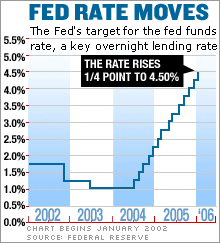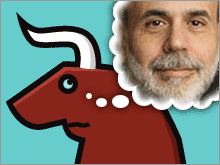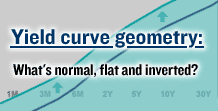What will the Fed say on Tuesday?
Many expect another rate hike at Bernanke's first meeting as central bank chief. But will he surprise them in the statement?
NEW YORK (CNNMoney.com) - Psst. Who's the new guy? And what's he up to? Investors gearing up for the first Federal Reserve policy meeting chaired by Ben Bernanke have a lot of questions. The most important, of course, is how much longer will the Fed keep raising rates?
The central bank's policy-makers began a two-day meeting Monday afternoon. And certainly, there is no doubt about what the central bank will do at the conclusion of it on Tuesday. According to futures contracts on the Chicago Board of Trade, investors are pricing in a 100 percent chance of getting at least a quarter-percentage point rate increase at the meeting. A quarter-point hike would be the 15th straight since the Fed started raising rates and would boost the fed funds rate, the overnight bank lending rate controlled by the Fed, to 4.75 percent. Yet, as has been the case over the past few years, "the question is not what they (the central bankers) do, but what they say in the statement and how they say it," said Stephen Stanley, chief economist at RBS Capital. Mind the apple cart
In particular, investors will be looking to see if the Fed changes the language in its statement and whether that means another hike is on tap for the Fed's next meeting on May 10 -- and perhaps even after its two-day meeting in late June. Since the Fed began raising rates in late June 2004, it has been using the term "measured" to describe the magnitude of future rate increases. Wall Street interpreted that to mean that more quarter-point hikes were on the way. But the Fed cut "measured" from its statement in January, suggesting to some that the central bank is almost done raising rates. Mining the Fed's statement for clues about future rate hikes was a favorite Wall Street parlour game during the tenure of former Fed chief Alan Greenspan. But Steve Van Order, chief fixed income strategist at Calvert Funds, said the statement from next week's meeting is unlikely to provide much help to investors. "The Fed has definitely been telegraphing more hikes of late, but I think they'll probably keep much of the same language they had in the January statement," Van Order said. As the new guy, "Bernanke will want to demonstrate policy continuity by not changing the language too much," said Wan-Chong Kung, senior portfolio manager at First American Funds. She noted that in his speech before the Economic Club of New York Monday night, he talked about how positive it was that the rate hikes of the last 21 months have been both gradual and clearly signaled to the markets in advance. "Much like Greenspan, he has a high sensitivity to not upset the apple cart," she said. Both the short statement from the Jan. 31 meeting and the meeting minutes -- released in February -- showed that Fed policy-makers think the economy is growing and that core inflation has been steady. Stop at 4.75% or keep on hiking?
The latest round of economic figures may have created some confusion, though. "A few weeks ago, the market was looking for a hike in March and May, but there have been some data points recently that have thrown May into question," RBS Capital's Stanley said, including last week's milder-than-expected rise in the core Consumer Price index, a key measure of inflation. The Fed has stated that it's raising rates to keep inflation in check, but some critics are concerned that if the central bank keeps raising, it risks slowing the economy. Some market observers also note that rates are now nearing a so-called "neutral" level that should neither encourage inflation nor hinder economic growth. "I don't know about another hike in May," said Van Order at Calvert Funds. "It's getting tougher to determine, as we get nearer to a fed funds rate that's close to neutral." But in his speech on Monday, Bernanke dismissed concerns about the economy. He said the recent flattening of the yield curve shouldn't be taken as a sign of a slowing economy, nor did it have clear implications for monetary policy. (For more details on Bernanke's speech, click here.) A flat yield curve results when short-term bond yields and longer-term bond yields are essentially the same. That's happened as the Fed has boosted short-term rates but the longer-dated Treasuries haven't budged much. In fact, rates for the 2-year Treasury note slightly exceeded that of longer-term bonds as of Thursday, an unusual situation called an inverted yield curve. Economists worry about inverted yield curves because they have often preceded a recession. Still, fed funds futures show investors are currently pricing in a more than 90 percent chance that rates will hit 5 percent by June, which suggests they are anticipating another hike in May. Bill Davison, managing director of fixed income at Hartford Investment Management, said he's betting on another quarter-point hike at both the May and June meetings before the Fed pauses. That would leave the Fed's short-term rate at 5.25 percent. "It's clear that [Bernanke] believes the economy is stronger than what the market is anticipating," Davison said. For CNNMoney.com's special coverage of the Fed and interest rates, click here.
For a closer look at the bond markets, click here. |
| ||||||||||||||||||||||||






